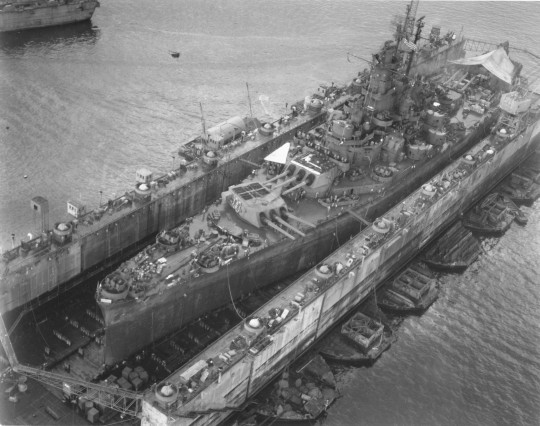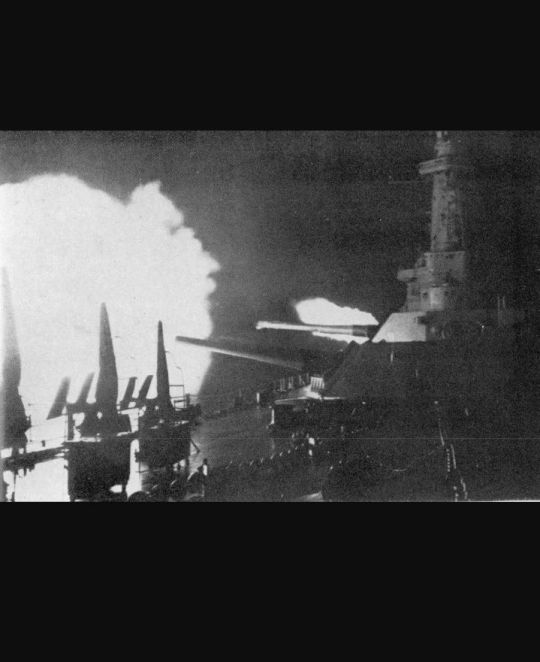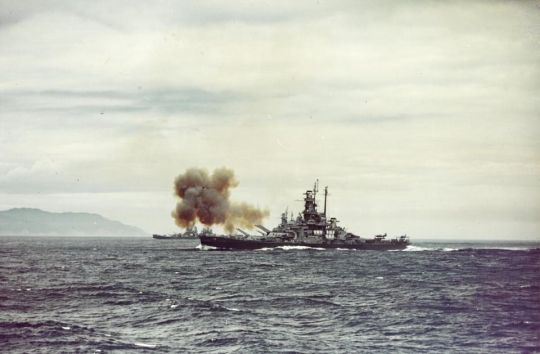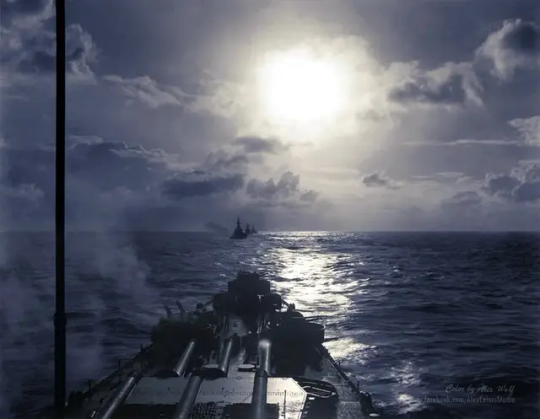#USS South Dakota
Text

Crewmen haul down the National Ensign as USS SOUTH DAKOTA (BB-57) is decommissioned, at the Philadelphia Naval Base, Pennsylvania.
Date: January 31, 1947
U.S. Naval History and Heritage Command: NH 73929
#USS SOUTH DAKOTA (BB-57)#USS SOUTH DAKOTA#South Dakota Class#Battleship#Warship#Ship#United States Navy#U.S. Navy#US Navy#USN#Navy#Philadelphia Navy Yard#Philadelphia#Pennsylvania#East Coast#Delaware River#January#1947#post war#postwar#decommissioning#decommission#my post
19 notes
·
View notes
Photo

Cuirassé USS South Dakota (BB-57) en réparation dans la cale sèche flottante USS ABSD-6 (Advance Base Sectional Dock-6) – Ile de Guam – 1945
Le 6 mai 1945, le cuirassé South Dakota reçoit des munitions depuis le bateau ravitailleur USS Wrangell (AE-12) sur l'île d'Okinawa. Pendant le chargement une charge de poudre explosa dans le magasin de la tourelle n°2 des canons de 410 mm. Le magasin fut inondé immédiatement pour éviter une explosion générale. 11 marins furent tués et 24 autres furent blessés dans l'accident.
Le cuirassé fut ramené à Guam pour réparations dans une cale sèche flottante, l'USS ABSD-6. Véritable chantier naval autonome, avec 2 grues mobiles sur rails, centrales électriques, pompes de ballast, ateliers de réparation et ateliers d'usinage, l'USS ABSD-6 pouvait recevoir pour réparations porte-avions, cuirassés et croiseurs en leur évitant de retourner à leur port d'attache réduisant ainsi considérablement de plusieurs mois les délais de retour au combat.
#WWII#Guerre du Pacifique#Pacific War#Marine américaine#US Navy#USN#Marine militaire#Military navy#Cuirassé#Battleship#Classe South Dakota#South Dakota class#USS South Dakota (BB-57)#USS South Dakota#BB-57#Réparations#Repairs#Réparation navale#Ship repair#Cale sèche#dry dock#Advance Base Sectional Dock#USS ABSD-6#Ile de Guam#Guam Island#Guam#Etats-Unis#United States of America#USA#1945
3 notes
·
View notes
Text

い~どぅ~
150 notes
·
View notes
Text

USS South Dakota (BB-57) in the floating drydock ABSD-3 at Guam.
77 notes
·
View notes
Text

USS South Dakota retrieves an OS2U Kingfisher, April 1943
71 notes
·
View notes
Text

USS Alabama Battleship
USS Alabama (BB-60) is a retired battleship. She was the fourth and final member of the South Dakota class of fast battleships built for the United States Navy in the 1930s
#battleships#uss alabama#navy ships#muttball#travel photography#photography#travel america#mobile alabama#image by muttball
48 notes
·
View notes
Text

South Dakota-class Battleship USS Indiana entering San Francisco bay, 1945.
193 notes
·
View notes
Photo

This year’s Freedom Rock is almost done. For the 24th straight Memorial Day, Bubba Sorensen’s 60-ton boulder near Greenfield, Iowa has a fresh, patriotic coat of paint. He describes it this way:
“This year’s front road-facing side is an illustration depicting a flag-draped coffin, lifted by a member of every branch of the military, and a soldier handing us (America) a folded flag, symbolizing that we are receiving the responsibility of upholding America for all those who’ve made the ultimate sacrifice in service to our country. It is accompanied by a partial quote from President Reagan “...stand in silence and remember those who were loved and who, in return, loved their countrymen enough to die from them.” On the south side of The Freedom Rock® is a depiction of the USS Ranger aircraft carrier with a Tomcat taking off. The Ranger was known as the “Top Gun of the Pacific” since some of the first Top Gun movie was filmed aboard that carrier. Next to that on the east side, is in honor of the 35th Anniversary of the attack on the USS Stark. Continuing around to the Northeast is Medal of Honor recipient John Baker and an illustration of a Tunnel Rat and their patch (Baker was a Tunnel Rat). Above this is the Huey helicopter that contains the ashes of over 125 Vietnam Veterans in the paint. Beside that is David Elsbernd who was killed in Vietnam and a recipient of the Purple Heart. He was vetoed off the North Dakota Freedom Rock® but thought he deserved to be recognized, as do all who are on the wall in DC. Of course, the American flag meets the POW/MIA flag on top.”
Bubba will be at the Freedom Rock along Highway 25 Memorial Day weekend.
46 notes
·
View notes
Text

F4U-4 Corsair To Be Loaned To Fagen Fighters WWII Museum
August 21, 2023 Angela Decker Aviation Museum News 0
John Sinclair giving instruction to Evan Fagen in the Corsair. Photo via Fagen Fighters Museum
Aircorps Art Dec 2019
by Adam Estes
The Fagen Fighters WWII Museum in Granite Falls, Minnesota, has just announced that will display F4U-4 Corsair BuNo 97388 through a loan agreement with owners

Photo via Fagen Fighters Museum
Bureau Number 97388 was taken on strength with the US Navy on April 26, 1946 and delivered four days later on April 30. The first two years of its service life would see it being assigned to several Naval Air Stations on the West Coast, such as Tillamook from June 1946 to October 1947, Santa Ana until March 1948, and San Diego until October of that year, when it was transferred to Marine Fighter Squadron 225 (VMF-225) at MCAS Cherry Point, North Carolina. June of 1949 would see 97388 sent to join VMF-212, which was in Japan at that time. Though the aircraft’s recorded history with VMF-212 contains no specific dates or locations for which exact bases in Japan it served at, the squadron would become involved in air operations at the outset of the Korean War. In the first two months of the conflict, it is highly probable that 97388 took part in combat missions launched from Japan to stem the tide of the initial North Korean advance into South Korea. Its time in combat would be cut short, however, as the aircraft would be sent back to the US in August of 1950 for overhaul and maintenance at NAS Quonset Point, Rhode Island before it would be reassigned to Fleet Air Service Squadron 3 at NAS Norfolk, Virginia. The following month, on September 14, BuNo 97388 would be assigned to VF-42. This posting would see the Corsair flying from NAS Oceana and NAS Jacksonville before being taken on a tour of the Mediterranean aboard the light carrier USS Saipan (CVL-48) from May to June of 1951, before being sent to NAS Cecil Field, Florida two months later. After a final deployment with VF-42 at NAS Oceana from November 1951 to May 1951, 97388 would undergo maintenance and overhaul at NAS Quonset Point until January 1953, when the aircraft was used primarily for reserve training at NAS Olathe, Kansas and NAS Grosse Ile, Michigan. In June of 1956, the aircraft was sent into storage at NAS Litchfield Park, Arizona before being decommissioned the following month.
After sitting outdoors at Litchfield Park, the aircraft was purchased by aircraft trader and pilot Bob Bean on November 25, 1957, who registered the Corsair as N5211V. One year later, Bean would later arrange for a trade between himself and the Honduran Air Force (Fuerza Aérea Hondureña, FAH) where 10 Corsairs (including 97388) would be shipped to Honduras in exchange for four P-38 Lightnings and four P-63 Kingcobras. In the FAH, 97388 would be identified as serial number 610, and while other Honduran Corsairs would later see combat in the Football War against El Salvador in 1969, FAH 610 had been struck off charge at the FAH Air Base at Toncontin International Airport in the capital city of Tegucigalpa, serving a source of spare parts to keep the other Corsairs flying.

Photo via Fagen Fighters Museum
FAH 610 would remain at Toncontin until 1978, when it was one of seven Honduran Corsairs returned to the United States by George Heaven & Jim Nettle of Hollywood Wings in Long Beach, California. By this point, the airframe was more a collection of parts then an airplane, and would require extensive restoration work to bring back into the skies. It would be stored in Long Beach until 1981, when it was purchased by Earl Ware of Jacksonville, who then kept the fuselage remains in his backyard, along with three other incomplete Honduran Corsairs (These being FAH 611 (USN BuNu 97382), FAH 617 (BuNo 97059), and FAH 692) until it was sold in 1982 to famed warbird restorer and pilot Gerald “Gerry” Beck of North Dakota, who would go on to spend the next 16 years meticulously returning 97388 back to airworthy condition at his shopTri-State Aviation in Wahpeton. When completed, 97388 emerged from the workshop in the markings it wore when assigned to VF-42.
After making its first post-restoration flights in 1998, Beck and 97388 would appear at EAA Airventure later that year. Over the years, 97388 would make appearances at numerous airshows and was a regular at the Fargo Air Museum in Fargo, North Dakota during the offseason, though it would later become a yearlong resident of Fargo as Beck focused on his “homebuilt” P-51A “Precious Metal II”. With the tragic death of Beck in 2007, his wife Cindy retained the Corsair and would ferry it back from Fargo to Wahpeton for refurbishment. Once completed by Tri-State in December of 2016, 97388 would be displayed at the Wings of the North Air Museum in Eden Prairie, Minnesota and was a feature of museum events such as AirExpo. With the unfortunate news of the museum’s public closure and ongoing search for a new home, Cindy and Whitney Beck have now decided to loan the Corsair to the Fagen Fighters WWII Museum. Given the wide variety of aircraft at Fagen’s expanding museum, it is indeed fortunate that 97388 has a secure home to continue flying the Midwestern skies. For more information about the Fagen Fighters WWII Museum, visit www.fagenfighterswwiimuseum.org.
5 notes
·
View notes
Text

"Lead ship of a new class of more compact fast battleships, USS South Dakota (BB-57) had the same speed and gun battery as the North Carolina class, but she had a better armor-protection scheme. She underwent mothballing at Philadelphia in 1946, the fate of nearly all the battleships at war's end. This photo, taken in 1962, shows the mothball period coming to an end as the ship, with less than five years' commissioned service on her record, is towed away to be scrapped."
(Naval Institute Collection)
#USS SOUTH DAKOTA (BB-57)#USS SOUTH DAKOTA#South Dakota Class#Battleship#Warship#Ship#United States Navy#U.S. Navy#US Navy#USN#Navy#November#1962#my post
26 notes
·
View notes
Photo

Le cuirassé USS Alabama (BB-60) au départ de Pearl Harbor pour la côte Est des Etats-Unis – 10 septembre 1945
©United States Navy - Photo 355416
#WWII#Après-guerre#After war#Marine américaine#US Navy#Marine de guerre#Navy#Marine militaire#Military navy#Cuirassé#Battleship#Classe South Dakota#South Dakota class#USS Alabama#BB-60#Pearl Harbor#Etats-Unis#United States of America#USA#10/09/1945#09/1945#1945
5 notes
·
View notes
Photo

Part 2 – “A Duel Of Titans” Truth is stranger than fiction – in the wild melee and darkness, Washington inadvertently closes on Kirishima, but doesn’t fire because they’ve lost track of South Dakota; incredibly, the Japanese don’t see Washington. When Kirishima opens on South Dakota, revealing their identity, they have no idea there is an American battlewagon lurking in the darkness with NINE 16-inch Mk. VI guns… and she’s only 8,400 yards away. For our audience at home, 8,400 yards is LESS THAN FIVE MILES. As we always try to relate to Sandy Hook in some way, if you’ve ever been to the Hook, that is the approximate distance from the Entrance to the Park… to the Sandy Hook Lighthouse!!! If there was ever an instance of Point Blank Range... you're looking at it. The Japanese only find out Washington is there when nine 16-inch, one-ton shells rip into her only seconds after they clear the tubes. Washington, with complete impunity, pours salvo after salvo into Kirishima. Please look very carefully at these photos, taken from Washington’s deck as she fires full broadsides that fateful night. Each gun barrel is 61 feet long, weighs 96 tons, and is designed to hurl a shell weighing a ton 25 miles away… and they are almost parallel to the ocean’s surface. That shows just how close the range of this fight truly was. The two massive ships trade salvo after salvo –but only Washington’s radar guided guns find their mark. Washington’s guns mercilessly rake Kirishima. Up to twenty 16-inch shells, and countless rounds of 5-inch shells, turn her into a flaming wreck. Her rudder controls shot away, listing badly, and her guns inoperable, she is ultimately scuttled, and joins dozens of other ships on the sea floor, adjacent to Savo Island and “Iron Bottom Sound.” 212 Japanese Sailors go with her. With a majority of his other ships damaged, Admiral Kondo turns tail…. And withdraws. The USS Washington has just made the first battleship to battleship kill of the US Navy since the Spanish American War, 44 years prior. A page of the Battle of Guadalcanal, and naval history, has been turned. And the crew of an American battlewagon are the ones who turned it. (at Fort Hancock, New Jersey) https://www.instagram.com/p/ClDGtYfNeLV/?igshid=NGJjMDIxMWI=
7 notes
·
View notes
Text

USS Indiana (BB-58) fires a salvo from her forward 16/45 guns at the Kamaishi plant, 250 miles north of Tokyo. Moments before, USS South Dakota (BB-57), from which this photo was taken, fired the first naval gunfire bombardment of the Japanese Home Islands. 14 July 1945.
0 notes
Text

The USS South Dakota (BB-57) left California on her final Pacific voyage. She transited through the Panama Canal, and arrived at the Philadelphia Naval Shipyard on 20 January for a yard overhaul. In June of the same year she was attached to the Atlantic Reserve Fleet. On 31 January 1947, she was decommissioned and placed in reserve status.
Photo- The SOUTH DAKOTA arrives at the Philadelphia Naval Shipyard on 20 January 1946.
61 notes
·
View notes
Text

United States battleships Indiana (BB-58), Massachusetts (BB-59), and Alabama (BB-60) in combat formation underway seen from USS South Dakota, 1945.
32 notes
·
View notes
